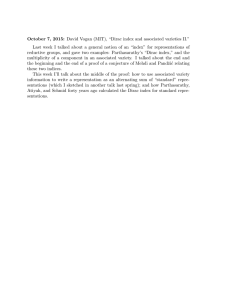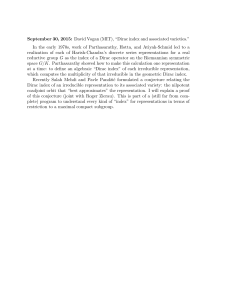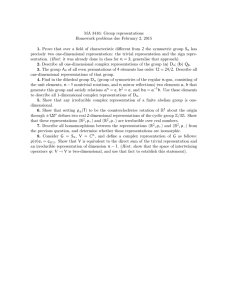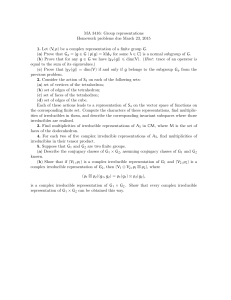Dirac family construction of K-classes 1 Overview A.P.M. Kupers
advertisement
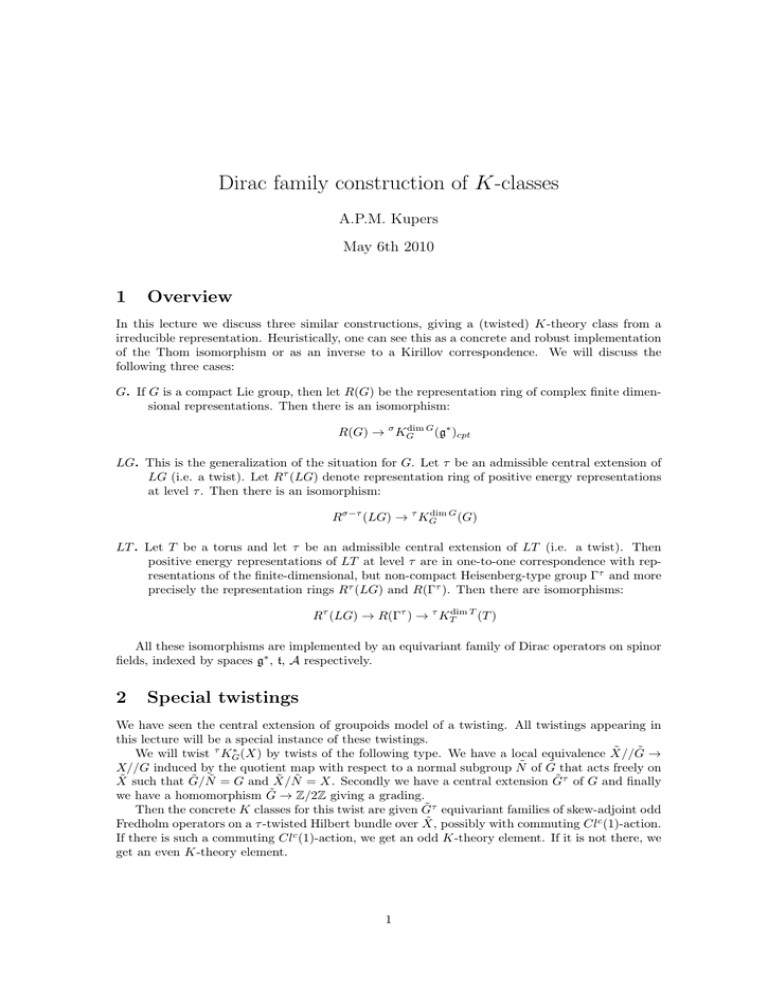
Dirac family construction of K-classes A.P.M. Kupers May 6th 2010 1 Overview In this lecture we discuss three similar constructions, giving a (twisted) K-theory class from a irreducible representation. Heuristically, one can see this as a concrete and robust implementation of the Thom isomorphism or as an inverse to a Kirillov correspondence. We will discuss the following three cases: G. If G is a compact Lie group, then let R(G) be the representation ring of complex finite dimensional representations. Then there is an isomorphism: dim G ∗ R(G) → σ KG (g )cpt LG. This is the generalization of the situation for G. Let τ be an admissible central extension of LG (i.e. a twist). Let Rτ (LG) denote representation ring of positive energy representations at level τ . Then there is an isomorphism: dim G Rσ−τ (LG) → τ KG (G) LT . Let T be a torus and let τ be an admissible central extension of LT (i.e. a twist). Then positive energy representations of LT at level τ are in one-to-one correspondence with representations of the finite-dimensional, but non-compact Heisenberg-type group Γτ and more precisely the representation rings Rτ (LG) and R(Γτ ). Then there are isomorphisms: Rτ (LG) → R(Γτ ) → τ KTdim T (T ) All these isomorphisms are implemented by an equivariant family of Dirac operators on spinor fields, indexed by spaces g∗ , t, A respectively. 2 Special twistings We have seen the central extension of groupoids model of a twisting. All twistings appearing in this lecture will be a special instance of these twistings. ∗ We will twist τ KG (X) by twists of the following type. We have a local equivalence X̃//G̃ → X//G induced by the quotient map with respect to a normal subgroup Ñ of G̃ that acts freely on X̃ such that G̃/Ñ = G and X̃/Ñ = X. Secondly we have a central extension G̃τ of G and finally we have a homomorphism G̃ → Z/2Z giving a grading. Then the concrete K classes for this twist are given G̃τ equivariant families of skew-adjoint odd Fredholm operators on a τ -twisted Hilbert bundle over X̃, possibly with commuting Clc (1)-action. If there is such a commuting Clc (1)-action, we get an odd K-theory element. If it is not there, we get an even K-theory element. 1 3 P inc and spinors Let V a real vectorspace with inner product. The dual V ∗ with dual inner product gives us a complex Clifford algebra Clc (V ∗ ) This contains as a subgroup Spinc (V ), which is a central extension of SO(V ) by T: 1 → T → Spinc (V ) → SO(V ) → 1 This extension can be generalized to O(V ), giving a group P inc (V ) ⊂ Clc (V ∗ ) which is a central extension of O(V ) by T: 1 → T → P inc (V ) → O(V ) → 1 This gives a short exact sequence of Lie algebras: 0 → iR → pinc → o → 0 and this is canonically split by a map o → pinc . The representation theory of Clc (V ∗ ) is pretty easy (see [Pre86, chapter 12]). We consider c Cl (V ∗ ) as a Z/2Z-graded algebra with graded representations. If dim V is even, there exist two irreducible Z/2Z-graded representations, which are isomorphic up to a graded shift. We fix one. If dim V is odd, there exists one irreducible representation, which allows a commuting Clc (1)-action. We will keep track of this action. For any value of dim V , we can therefore fix a irreducible graded spinor representation S, with a commuting Clc (1)-action if dim V is odd. In the infinite dimensional case, working with a Hilbert space H, this theory works similarly, expect that one needs to fix a polarization of the Hilbert space first. Roughly one needs to seperate positive from negative energy vectors. 4 The theorem for G There is a canonical central extension Gσ of G. Consider the adjoint representation Ad : G → O(g). We can use this to form the pullback Gσ : P inc (g) ×O(g) G. This acts on the spinor representation S of P inc (g) through projection. We denote the infinitesimal action of g through the splitting pinc using the splitting by σ. There is an additional Clifford multiplication action of g∗ , which we denote by γ. Fix a basis ea of g and denote the dual basis by ea . Then we denote the action of ea through spinor multiplication by σa and the action of ea through Clifford multiplication by γ a . If we trivialize the cotangent bundle of G by left translation, then the spinor fields (obtained by the construction explained earlier, by fiberwise constructing an irreducible Clc (Tg∗ G) representation) can be identified with C ∞ (G) ⊗ S. The infinitesimal version of the left translation action of C ∞ (G) gives another action R of g. We denote the action of ea by Ra . So we end up with a C ∞ (G) ⊗ S admitting three actions: σ by g, R by g and γ by g∗ . This allows us to define the Dirac operator family D: Definition 4.1 (The Dirac operator family D). Define D : g∗ → End(C ∞ (G) ⊗ S) as follows: i µ = µa ea 7→ Dµ = iγ a Ra + γ a σa + µa γ a 3 Each Dµ2 is indeed a generalized Laplacian, so this is a Dirac operator in the analytic sense. It is a skew-adjoint odd Gσ -equivariant operator and if S admits a commuting Clc (1)-action, Dµ commutes with this for each µ ∈ g∗ . However, C ∞ (G) ⊗ S is highly reducible, so we restrict our attention to smaller subspaces. To do this, we use the Peter-Weyl theorem: 2 Theorem 4.2 (Corollary of Peter-Weyl). L2 (G) ⊗ S decomposes as follows: M L2 (G) ⊗ S ∼ V∗⊗V ⊗S = V ∈Ĝ L where denotes the completed tensor product, Ĝ the set of irreducible representations of G, G acts on V ∗ by right translation, on V by left translation and projective on S through Gσ . By the Gσ -equivariance of the Dirac family, we can restrict it to V ∗ ⊗ V ⊗ S and because it doesn’t involve right translation, we can forget about the factor V ∗ . We denote the Dirac family restricted to V ⊗ S by D(V ). It is easily seen now, since V ⊗ S is finite dimensional, that is a Gσ -equivariant family of skewadjoint odd Fredholm operators with commuting Clc (1)-action if dim g is odd. We claim that it is compactly supported over the coadjoint orbit of −λ − ρ, where −λ is lowest weight of V and −ρ P with ρ = 21 α∈∆+ α is the lowest weight of S as a Gσ -representation, where ∆+ denotes the set of positive roots. This is proven by calculating the character and the dimension of S and using the Weyl character and dimension formulae to link S to the standard representation of lowest weight −ρ. To do the calculation of the kernel of Dµ for a fixed µ ∈ g∗ , we pick a maximal torus Tµ and a weight-space decomposition such that µ is antidominant. Proposition 4.3. If V is irreducible, then ker Dµ is V−λ ⊗ S−ρ is µ = −λ − ρ. Sketch of proof. One defines an energy operator Eµ which behaves as multiplication by a positive constant on weight space and achieves its lowest value on the lowest weight space V−λ ⊗S−ρ . From a simple calculation is follows that Dµ2 + 2Eµ is multiplication by a fixed constant on the entire space V ⊗ S. Therefore Dµ2 is maximal on the lowest weight space. A calculation of its value of V−λ ⊗ S−ρ then shows that is non-positive there and zero if and only if µ = −λ − ρ. This implies that we get a map from representations to twisted K-theory, where the twist is (g∗ //G → g∗ //G, Gσ , σ ). Theorem 4.4. The map Ψ : R(G) → σ K dim G (g∗ )cpt is a implementation of the twisted Thom isomorphism. Proof. It is homotopic through compactly supported Fredholm operators to the standard implementation of the Thom isomorphism, [V ] 7→ (V ⊗ S, id ⊗ γ). One can generalize these constructions to projective representations of G with cocycle τ , i.e. representations of a central extension Gτ of G. Then g∗ is replaced by the g∗ -torsor A of connections, which are in bijection with splittings gτ → g. These are necessarily to define Ra , which now depends on µ ∈ A. 5 The theorem for LG This theorem is closely related to the case of projective representations of G. The construction is very similar: one defines a family of Dirac operators to implement a map from irreducible positive energy representations to twisted K-classes. The main differences with the latter cases will be: • Analysis gets involved because Lg is infinite dimensional. For exmaple, one needs to work on dense subspaces of positive energy vectors. Similarly, there are some problems with naive definitions of P inc and the spinor representation S. These now depend on a polarization J. • Positive energy representations are projective, i.e. they are representations for some central extensions (LG)τ of LG. This requires the use of connections or (under suitable conditions) equivalently splittings (Lg)τ → Lg. 3 Let τ be an admissible central extension of LG. Roughly speaking, it means that the central extension extends to L̃G = TnLG and that there is a nice inner product on (L̃g)τ . For semisimple G every central extension is admissible. Let V be a positive energy representations of level τ − σ. Then an infinite dimensional spinor representation of Clc ((Lg)∗ ) exists. Let ea z n be a Fourier basis of Lg∗ . Then γ a (n) denotes the Clifford multiplication on S, σa (n) the spinor action of S and (Ra (n)) the infinitesimal action of ea z n on V with respect to connection A ∈ A (this uses the splitting Lg → (Lg)τ coming from the connection). Definition 5.1 (Dirac family). We define DA = iγ a (−n)(Ra (n))A + 2i γ(Ω)A as our Dirac family depending on a connection A ∈ A. If we fix a connection A0 , e.g. the trivial one, then this formula simplifies to Dµ = iγ a (−n)Ra (n) + 3i γ a (−n)σa (n) + γ(µ) for µ ∈ (Lg)∗ . However, Dµ involves differentation, so in general will not be bounded. Therefore, we replace 2 −1/2 it by FA = DA (1 − DA ) . One can then show, using the same techniques as for the case of τ G, that FA is a (LG) -equivariant family of skew-adjoint odd Fredholm operators on A, with commuting Clc (1)-action if dim G is odd. dim G Thus we get an element in τ KG (G) with τ the twist given by (A//LG → G1 //G, (LG)τ , ), where G1 is the identity component of G. This follows from the fact that the holonomy only takes values in G1 for a trivial G-bundle over the circle. dim G (G1 ) given by this Dirac family construction is Theorem 5.2. The map Ψ : Rτ (LG) → τ KG an isomorphism. This generalizes almost directly in two directions: gauge groups for any principal G-bundle P over S 1 (then we have to replace G1 with G[P ], the image of the holonomy) and fractional loops (then we replace the rotation circle by a finite cover). 6 The theorem for LT A simple case of the main theorem of [FHT07] is that of tori. It has the virtue of being reasonably hands-on and it is also of importance in the proof of the theorem. It is easy to prove LT is isomorphic to a product Γ × exp(V ) of the group Γ = Π × T of loops of which the projection of the velocity to t is constant and the exponential of the subspace of the Lie algebra Lt complementary to t (one can introduce the L2 -product one also uses for the Fourier decomposition of loops). Let Π denote the character lattice and Π∗ the cocharacter lattice. A homomorphism τ : Π → Π∗ can be considered as an element of H 1 (T ) ⊗ HT2 (T ) ∼ = H 1 (T ) ⊗ H 1 (T ) and hence as a twist. If it is of full rank, it is admissible and the central extension (LT )τ splits as Γτ × exp(V )τ . The former is a group of Heisenberg-type. The irreducible representations of Γτ ×exp(V )τ are easily classified. The group exp(V )τ admits a single irreducible positive energy representation, the FockL representation F. The Heisenbergtype group admits infinite dimensional representations V[λ] = λ∈[λ] Vλ indexed by [λ] ∈ Π∗ /τ (Π). L From this we see that L2 (T ) ⊗ S ∼ = ˆ V[λ] . This discussion shows that positive energy representations of LT at level τ are in bijection with representations of Γτ . We will link the latter to K-classes using the Dirac family described before. The map τ : Π → Π∗ induces a map τ̃ : Π → Π∗ . Therefore, the Dirac operator family Dµ = iγ a Ra + µa γ a (σa = 0 since it depends linearly on the structure constants of the Lie algebra t) on t∗ can be pulled back to a give a Dirac family τ̃ ∗ D. In fact, τ̃ ∗ D turns out to be a Γτ -equivariant family of skew-adjoint odd Fredholm operators on t, with commuting Clc (1)-action if dim τ is odd. Thus we obtain an element of τ KTdim T (T ) where the twist is (t//Γ → T //T, Γτ , τ ). Theorem 6.1. The map Ψ : R(Γτ ) → τ KTdim T (T ) given by this Dirac family construction is an isomorphism. 4 e In fact, using the isomorphism KTdim T (T ) ∼ (Λτ , Hcn (t) ⊗ Z[]), one can show that = HomWaf f [λ] is mapped to a function supported on [λ] after identifying the Π∗ -torsor Λτ with Π∗ . References [FHT07] D.S. Freed, M.J. Hopkins, and C. Teleman. Loop groups and twisted k-theory ii. 2007. arxiv:math/0511232v2. [Pre86] S. Pressley, A. & Segal. Loop Groups. Oxford University Press, 1986. 5
